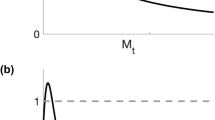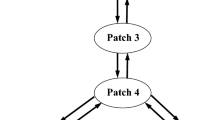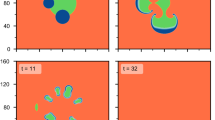Abstract
A general diffusive population model for interactions of pioneer and climax species subject to the no-flux boundary condition is considered. Local and global steady-state bifurcations as well as Hopf bifurcations are investigated. A condition for Turing instability not to happen is obtained, and the conditions for occurrences of Turing bifurcations and Hopf bifurcations are also obtained. Numerical simulations are carried out to demonstrate and extend the obtained analytic results which suggest that the spatial diffusion may make the climax species more dominant. The results indicate that the model, with spatial diffusion incorporated , can have very rich spatial–temporal dynamics.











Similar content being viewed by others
References
Allee, W.C.: Animal Aggregations: A Study in General Sociology. University of Chicago Press, Chicago (1931)
Brown, S., Dockery, J., Pernarowski, M.: Traveling wave solutions of a reaction diffusion model for competing pioneer and climax species. Math. Biosci. 194, 21–36 (2005)
Buchanan, J.R.: Asymptotic behavior of two interacting pioneer/climax species. Fields Inst. Commun. 21, 51–63 (1999)
Buchanan, J.R.: Turing instability in pioneer/climax species interactions. Math. Biosci. 194, 199–216 (2005)
Cantrell, R.S., Cosner, C.: Spatial Ecology via Reaction–Diffusion Equations, Wiley Series in Mathematical and Computational Biology. Wiley, Chichester (2003)
Dockery, J., Hutson, V., Mischaikow, K., Pernarowski, M.: The evolution of slow dispersal rates: a reaction–diffusion model. J. Math. Biol. 37, 61–83 (1998)
Henry, D.: Geometric Theory of Semilinear Parabolic Equations. Lecture Notes in Mathematics, vol. 840. Springer, Berlin (1981)
**, J., Shi, J., Wei, J., Yi, F.: Bifurcations of patterned solutions in the diffusive Lengyel–Epstein system of CIMA chemical reactions. Rocky Mt. J. Math. 43, 1637–1674 (2013)
Li, X., Jiang, W., Shi, J.: Hopf bifurcation and turing instability in the reaction–diffusion Holling–Tanner predator–prey model. IMA J. Appl. Math. 78, 287–300 (2013)
Liu, J., Wei, J.: Bifurcation analysis of a diffusive model of pioneer and climax species interaction. Adv. Differ. Equ. 52, 1–11 (2011)
Mizoguchi, N., Ninomiya, H., Yanagida, E.: Diffusion-induced blowup in a nonlinear parabolic system. J. Dyn. Differ. Equ. 4, 619–638 (1998)
Pao, C.V.: Nonlinear Parabolic and Elliptic Equations. Plenum, New York (1992)
Peng, R., Shi, J., Wang, M.: On stationary patterns of a reaction–diffusion model with autocatalysis and saturation law. Nonlinearity 21, 1471–1488 (2008)
Peng, R., Yi, F., Zhao, X.: Spatiotemporal patterns in a reaction–diffusion model with the Degn–Harrison reaction scheme. J. Differ. Equ. 254, 2465–2498 (2013)
Ricker, W.E.: Stock and recruitment. J. Fish. Res. Board Can. 11, 559–623 (1954)
Ruan, S., Wei, J.: On the zeros of transcendental functions with applications to stability of delay differential equations with two delays. Dyn. Contin. Discrete Impuls. Syst. Ser. A Math. Anal. 10, 863–874 (2003)
Selgrade, J.F., Namkoong, G.: Stable periodic behavior in a pioneer-climax model. Nat. Resour. Model. 4, 215 (1990)
Selgrade, J.F., Roberds, J.H.: Lumped-density population models of pioneer-climax type and stability analysis of Hopf bifurcations. Math. Biosci. 135, 1–21 (1996)
Song, Y., Zou, X.: Bifurcation analysis of a diffusive ratio-dependent predator–prey model. Nonlinear Dyn. 78, 49–70 (2014)
Su, Y., Zou, X.: Transient oscillatory patterns in the diffusive non-local blowfly equation with delay under the zero-flux boundary condition. Nonlinearity 27, 87–104 (2014)
Sumner, S.: Competing species models for pioneer-climax forest dynamical systems. Proc. Dyn. Syst. 1, 351–358 (1994)
Turing, A.M.: The chemical basis of morphogenesis. Phil. Trans. R. Soc. Lond. B 237, 37–72 (1952)
Verhulst, P.F.: Notice sur la loi que la population poursuit dans son accroissement. Corresp. Math. Phys. 10, 113–121 (1838)
Wang, J., Wei, J., Shi, J.: Global bifurcation analysis and pattern formation in homogeneous diffusive predator–prey systems. J. Differ. Equ. 260, 3495–3523 (2016)
Weng, P., Zou, X.: Minimal wave speed and spread speed of competing pioneer and climax species. Appl. Anal. 93, 2093–2110 (2014)
Yi, F., Wei, J., Shi, J.: Bifurcation and spatiotemporal patterns in a homogeneous diffusive predator–prey system. J. Differ. Equ. 246, 1944–1977 (2009)
Yuan, Z., Zou, X.: Co-invasion waves in a reaction diffusion model for competing pioneer and climax species. Nonlinear Anal. RWA 11, 232–245 (2010)
Zhou, J., Shi, J.: Pattern formation in a general glycolysis reaction difusion system IMA. J. Appl. Math. 80, 1703–1738 (2015)
Zuo, W., Wei, J.: Multiple bifurcations and spatiotemporal patterns for a coupled two-cell Brusselator model. Dyn. Partial Differ. Equ. 8, 363–384 (2011)
Author information
Authors and Affiliations
Corresponding author
Additional information
Research supported by the Natural Science and Engineering Council of Canada (Grant No. RGPIN-2016-04665), National Natural Science Foundation of China (No: 11201096, 11461024) and the Fundamental Research Funds for the Central Universities and Program for Innovation Research of Science in Harbin Institute of Technology.
Rights and permissions
About this article
Cite this article
Su, Y., Zou, X. Rich spatial–temporal dynamics in a diffusive population model for pioneer–climax species. Nonlinear Dyn 95, 1731–1745 (2019). https://doi.org/10.1007/s11071-018-4656-5
Received:
Accepted:
Published:
Issue Date:
DOI: https://doi.org/10.1007/s11071-018-4656-5




